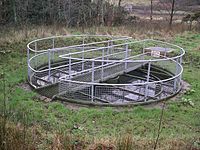
Photo from wikipedia
Inoculum plays an important role in establishing a bacterial community in biological treatment reactors. Two identical anaerobic-aerobic-anoxic sequencing batch reactors (SBRs) were inoculated with sludge from a municipal (R1) or… Click to show full abstract
Inoculum plays an important role in establishing a bacterial community in biological treatment reactors. Two identical anaerobic-aerobic-anoxic sequencing batch reactors (SBRs) were inoculated with sludge from a municipal (R1) or pharmaceutical (R2) wastewater treatment plant (WWTP) to investigate the influence of inoculum on the start-up of SBRs by comparing the pollutants removal efficiencies and bacterial community. Both SBRs were successfully started up within 30 d. Comparably high chemical oxygen demand (97% ± 2%), total nitrogen (89% ± 8%) and ammonia (96% ± 6%) removals were achieved in both SBRs. But R1 performed much better in total phosphorus removal (95% ± 6% vs. 69% ± 7%) than R2 due to a higher relative abundance of phosphorous-accumulating organisms (5.5% vs. 0.4%) in R1 at the end of the experiment. The bacterial community structures were distinctly different in the inoculating sludge, and no trend of becoming similar was observed all the time. Candidatus Competibacter was enriched to be the most dominant bacteria in both R1 (27.3%) and R2 (19.8%) during the start-up. However, Candidatus Moranbacteria (16.2%) and Roseiflexus (4.2%) were only dominant in R1, whereas Zoogloea (10.5%) and Anaerolineaceae (9.7%) were only dominant in R2 finally. These results indicated that inoculating sludge is one deciding factor shaping the microbiomes in bioreactors, and activated sludge from municipal WWTPs was a potential inoculum to start-up industrial wastewater biotreatment reactors with desirable performances.
Journal Title: Desalination and Water Treatment
Year Published: 2020
Link to full text (if available)
Share on Social Media: Sign Up to like & get
recommendations!